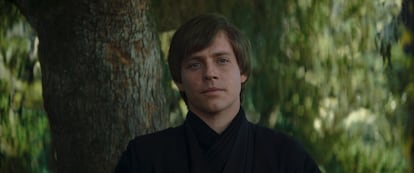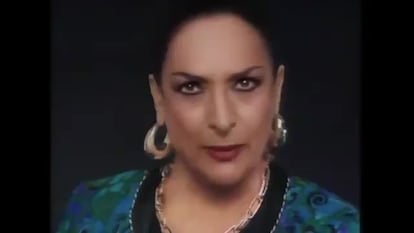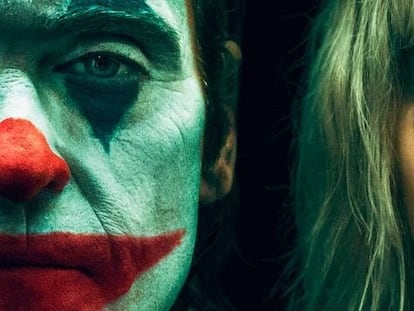‘Horrendous Frankensteinian monster’: The debate over digitally resurrecting Hollywood stars
As franchises like ‘Alien’ and ‘Star Wars’ resurrect iconic characters, there is growing discussion over the legal and ethical implications surrounding the use of deceased actors’ likenesses


For his last movie, James Earl Jones didn’t have to move a muscle. The legendary actor — who passed away on September 9 — simply granted Disney the rights to his vocal recordings, allowing the team behind the Obi-Wan Kenobi series to compile files and revitalize his portrayal of Darth Vader. While Jones’s iconic voice has defined the Star Wars villain for 45 years, this time, no human delivered the lines. Instead, a machine of Ukrainian origin replicated the tone and emotion that made his famous “I am your father” line unforgettable in 1980. With the consent of Lucasfilm and his heirs, Jones could potentially continue to “act” forever.
The trend of resurrecting dead actors in their iconic roles points in that direction. This summer, Alien: Romulus astonished audiences by bringing Ian Holm — who passed away in 2020 — back to life through a combination of animatronic robots and a digitized face and voice. The film transformed the android he portrayed in the 1979 classic into the central villain of the new plot (with a nod to the xenomorphs). However, critics and some viewers expressed concerns about the unsettling nature of his onscreen presence and what this means for the future of filmmaking.
When Entertainment Weekly asked about this nostalgic move — given that Michael Fassbender or Lance Henriksen, who also play androids in the saga, could have performed the role — director Fede Álvarez replied: “The whole thing started with me calling the estate and talking with his widow. She felt that Ian was given the cold shoulder by Hollywood in the last years of his life, that he would’ve loved to be part of more projects after The Hobbit, but he wasn’t. So she was thrilled about the idea of having him back.” It was a paradoxical decision given Alien: Romulus warns of the danger of large corporations controlling artificial intelligence (AI).
“I’m clear that we bring them back more for ourselves — to relive the emotions that only a few people have made us feel,” says special effects expert Alejandro Pérez Blanco.
The resurrection of actors through technology is fraught with legal issues. A prominent example is Peter Cushing, who was digitally revived for Rogue One: A Star Wars Story as Governor Moff Tarkin. The production company Tyburn — owned by Cushing’s friend Kevin Francis — is suing Disney, claiming that Cushing had signed a power of attorney a year before his death in 1994, granting only Tyburn permission to use his digital likeness for a project that was never realized.
Despite Disney’s attempts to block the lawsuit, a London judge, as reported by The Telegraph, has allowed it to proceed, on the grounds that it is “difficult to determine the boundaries without a thorough investigation.” Lucasfilm contends that it has the rights to recreate Cushing’s likeness based on his appearances in the original Star Wars and that it paid €33,000 ($36,000) to his heirs, who are also named in the lawsuit.
“If you’re paid, your perspective changes. But just because you’re family doesn’t mean you’ll make the right or best decision for your ancestors,” says Maite Soto-Sanfiel, a researcher and professor of communication at the University of Singapore, who has explored the ethical concerns around resurrecting actors through technology. She adds: “If I’m going through a tough time and someone offers money, it makes life easier. That’s why we must acknowledge that the deceased have rights — over their image, privacy, personality, intimacy, and the ability to say no. This is a serious, philosophical debate.”
Soto-Sanfiel views these digital recreations as a manipulation of memories and a violation of history, noting: “We’ll never truly know if they would have agreed to it.” Rogue One not only resurrected Cushing as Moff Tarkin, but also digitally recreated a young Carrie Fisher as Leia. However, in Fisher’s case, it was done with her consent just weeks before her passing.
These debates open up new legal gray areas. In California, where the film industry is often ahead of the curve, celebrities’ image rights are transferred directly to their heirs for 70 years after their death. The actors’ union recently secured — as part of the 2023 strike — a law stipulating that deceased actors can only be digitally resurrected with strict family consent. The law also requires that no prior agreements exist for transferring image rights. These provisions represent the only clear legal limits.
However, the situation differs across markets. Actors must now pay closer attention to the fine print in contracts, understanding what rights they may be signing away. Despite these protections, special effects expert Alejandro Pérez Blanco believes this is simply the latest chapter in a long-standing issue. “When Elvis died, Frank Sinatra was terrified that his image was everywhere, so he started his own company to prevent his face from being exploited in commercial products,” he recalls. “I always warn clients they need to be crystal clear about where the material is sourced and what the exploitation rights entail.” He adds that with the rapid pace of technological advancements, any law passed today could become outdated within five years.
Beyond the legal complexities, the ethical aspect raises significant concerns. “Even when they die, people are not mere things with which others can do as they please,” explains Sara Suárez-Gonzalo, from the Universitat Oberta de Catalunya, in an essay on deadbots. “This is why our societies consider it wrong to desecrate or to be disrespectful to the memory of the dead. In other words, we have certain moral obligations towards the dead, insofar as death does not necessarily imply that people cease to exist in a morally relevant way.”

This trend shows no sign of slowing down. Star Wars remains committed to reusing its most iconic actors. For Kathleen Kennedy, the head of Lucasfilm, a key turning point came with the film Solo: A Star Wars Story, where Alden Ehrenreich stepped into Harrison Ford’s shoes as Han Solo. Reflecting on the experience, Kennedy admitted in an interview with Vanity Fair: “That may have certainly been a learning moment. [...] We would never make Indiana Jones without Harrison Ford,” implying that digitally recreating or reviving classic characters, rather than recasting them, might be the future.
That’s why, in The Mandalorian and The Book of Boba Fett, the production team opted to cast an actor who resembled a young Mark Hamill, in order to overlay his face using deepfake technology in post-production. Although Hamill himself recorded some scenes, AI was used to replicate his appearance, face, and voice. This method produced a more convincing result than the digital de-aging techniques used in films like The Irishman or Indiana Jones.
“New actors won’t have the chance to say new things,” laments Soto-Sanfiel. She questions why there isn’t more debate about this trend. “Why is it that we don’t discuss whether John Williams’ music should be altered by other composers, yet we’re okay with manipulating Luke Skywalker’s face?” she asks.
Pérez Blanco offers a different perspective: “For me, the de-aged sequence in Indiana Jones is the closest thing I have to watching a film as a child — as if there was a movie you didn’t know existed.”
The standard approach, then, is to reach agreements with the actor’s heirs. “You just get permission, and everything’s OK,” said cinematographer Eric Adkins, who helped digitally revive Laurence Olivier in Sky Captain and the World of Tomorrow, in The Hollywood Reporter. Jude Law, the film’s lead actor, personally sought approval from Olivier’s widow.
A similar process occurred with the revival of Harold Ramis (who passed away in 2014) for Ghostbusters: Afterlife. In that film, his ghostly character Egon Spengler played a pivotal role, and director Jason Reitman said he made sure the Ramis family supported the idea: “They were part of this movie from start to finish and I think they were aware of how much I wanted to honor Harold.”
This wasn’t just a brief appearance — it was a significant supporting role, much like Holm’s in Alien: Romulus and Fisher’s in Star Wars: The Rise of Skywalker, where her performance was completed with footage from previous films, and her daughter, Billie Lourd, acted as a body double. Paul Walker’s character in Fast & Furious also received a similar farewell, with his brother standing in as a body double, digitally enhanced to match Walker’s face in his final ride into the sunset.
In some cases, the use of technology to resurrect actors arose out of necessity, but the industry is now on the cusp of elevating it to a new level, driven by nostalgia. In 2019, James Dean’s family agreed to digitally revive the actor, who passed away in 1955, to star in Finding Jack, a Vietnam War drama. “The family views this as his fourth movie, a movie he never got to make,” said director Anton Ernst.
But the move received a lot of criticism on social media. Actor Chris Evans, for example, posted: “This is awful. Maybe we can get a computer to paint a new Picasso. Or write a couple of new John Lennon songs. The lack of understanding is shameful.”
The decision sparked a broader debate about the ethics of resurrecting actors. Some families are more cautious about profiting from deceased loved ones. Zelda Williams, daughter of comedian Robin Williams, has been vocal against using technology to turn the dead into a “horrendous Frankensteinian monster,” warning that it sets a dangerous precedent as technology continues to improve. Her father, wary of this future, had specifically written into his will that his image could not be used for 25 years after his death.
In some instances, there has been no communication with the families of deceased actors. For example, in January, Christopher Reeve’s children revealed during the presentation of a documentary about their father, set to premiere on October 11, that they had neither seen the recreation of his Superman character in a cameo for The Flash, nor had anyone at Warner Bros. reached out to them.
This isn’t the first time the superhero franchise has sparked controversies over resurrecting actors; Marlon Brando’s likeness was reused in Superman Returns in 2006, two years after his death, utilizing unused footage from his iconic role, for which he was famously paid $3.7 million for just two weeks of work. In that case, Brando’s family did approve the use of the footage, ensuring they continued to benefit financially from his legacy.
The company responsible for resurrecting James Dean, Worldwide XR, announced at the time that it held the rights to 400 deceased celebrities, including actors, historical figures, musicians, and athletes. In 2013, Audrey Hepburn was brought back to life in a chocolate advertisement, with her son benefiting from the proceeds.
In Spain, Lolita and Rosario Flores featured in a beer commercial where their mother, Spanish actress Lola Flores, spoke again 16 years after her death. This particular case left researcher Soto-Sanfiel astounded: “What right did the daughters have to use her to sell beer? They do it either for profit or to relive emotional moments, but we can never know what she would have done. Is reviving the past truly a healthy thing to do?”
Soto-Sanfiel often illustrates this dilemma with her students: “We have the technology to make cars go at 250 miles per hour, but we collectively agreed not to use that capability. We made a moral decision. With AI, we can replace actors, but we must question the reasons and methods behind it. What genre does this fit into? Do we label it as fake? These are decisions made from a position of power, and the deceased often become vulnerable victims rather than creative resources. It’s crucial to establish moral boundaries and engage in this debate.”
Despite these concerns, there’s a consensus that this trend is here to stay.
Sign up for our weekly newsletter to get more English-language news coverage from EL PAÍS USA Edition
Tu suscripción se está usando en otro dispositivo
¿Quieres añadir otro usuario a tu suscripción?
Si continúas leyendo en este dispositivo, no se podrá leer en el otro.
FlechaTu suscripción se está usando en otro dispositivo y solo puedes acceder a EL PAÍS desde un dispositivo a la vez.
Si quieres compartir tu cuenta, cambia tu suscripción a la modalidad Premium, así podrás añadir otro usuario. Cada uno accederá con su propia cuenta de email, lo que os permitirá personalizar vuestra experiencia en EL PAÍS.
¿Tienes una suscripción de empresa? Accede aquí para contratar más cuentas.
En el caso de no saber quién está usando tu cuenta, te recomendamos cambiar tu contraseña aquí.
Si decides continuar compartiendo tu cuenta, este mensaje se mostrará en tu dispositivo y en el de la otra persona que está usando tu cuenta de forma indefinida, afectando a tu experiencia de lectura. Puedes consultar aquí los términos y condiciones de la suscripción digital.
More information
Archived In
Últimas noticias
There is as much life left to discover on planet Earth as that which is already known
Dozens presumed dead, around 100 injured in fire at Swiss Alps bar during New Year’s celebration
Is porn for women different from conventional porn? We spoke to those who make it
Cartagena de Indias is sinking: What can the city do to mitigate it?
Most viewed
- Sinaloa Cartel war is taking its toll on Los Chapitos
- Reinhard Genzel, Nobel laureate in physics: ‘One-minute videos will never give you the truth’
- Oona Chaplin: ‘I told James Cameron that I was living in a treehouse and starting a permaculture project with a friend’
- David King, chemist: ‘There are scientists studying how to cool the planet; nobody should stop these experiments from happening’
- Why the price of coffee has skyrocketed: from Brazilian plantations to specialty coffee houses











































